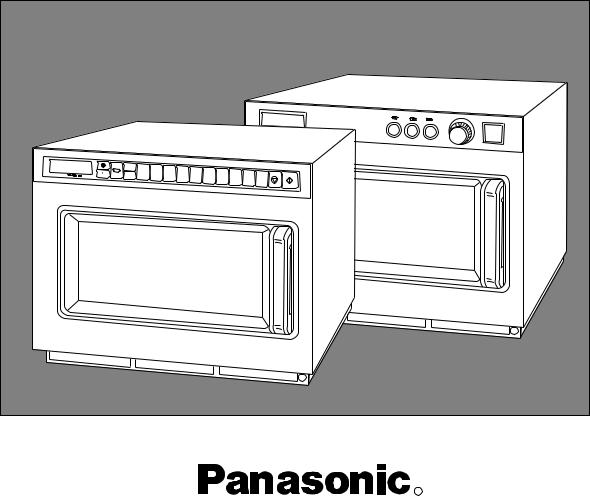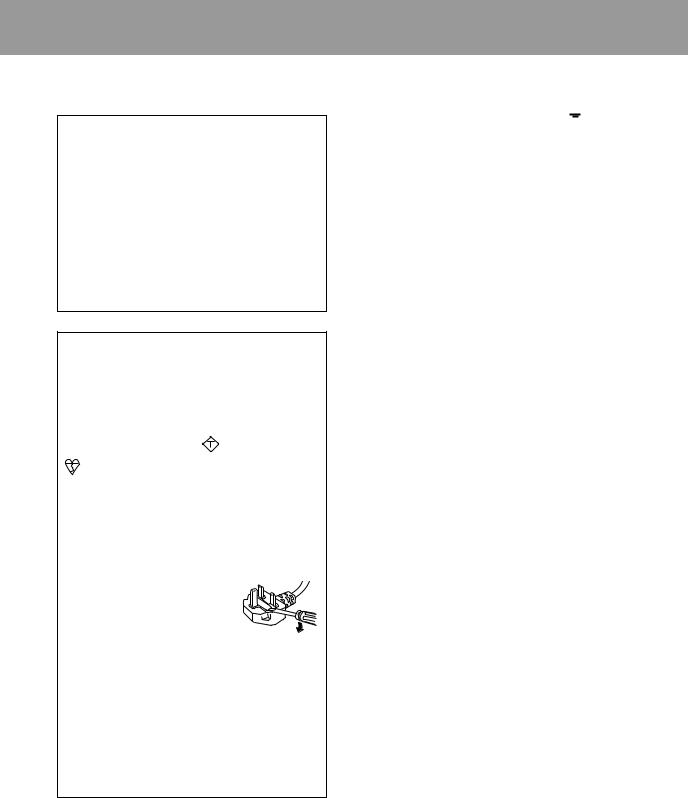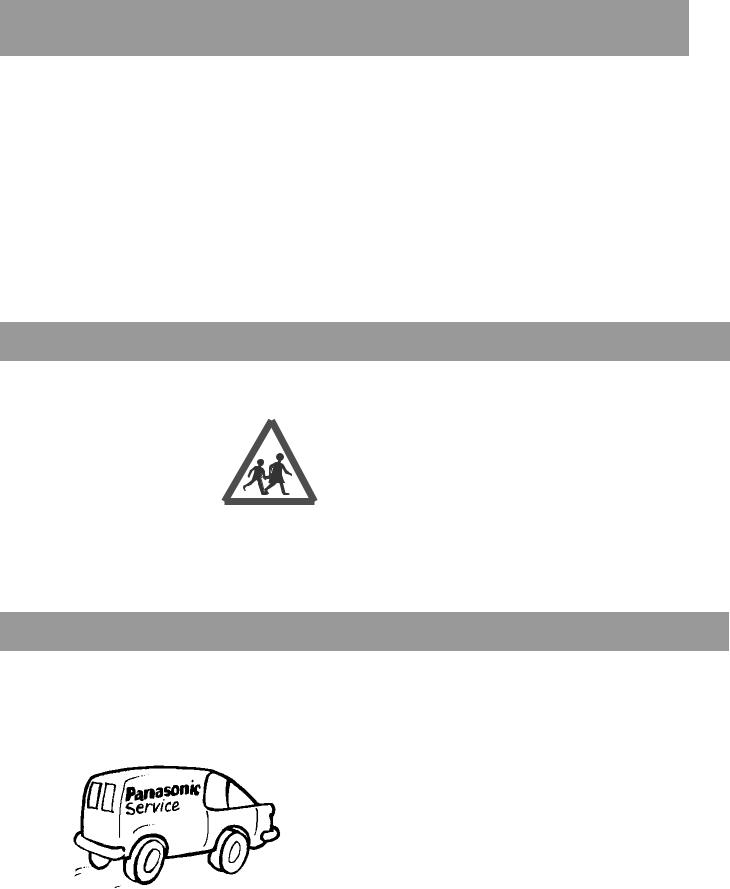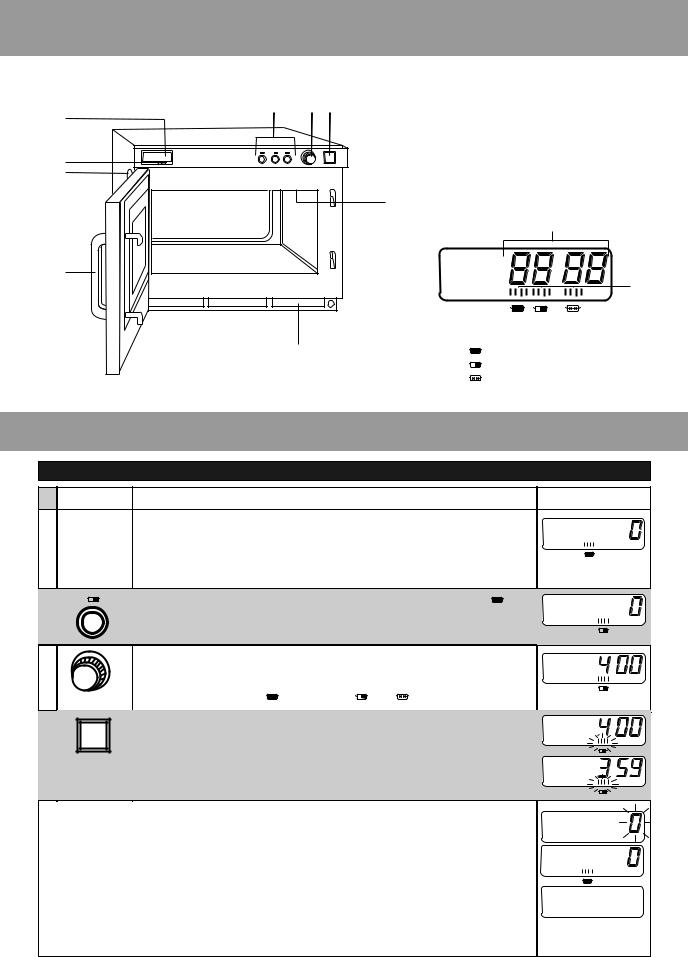Panasonic NE-2156, NE-1856, NE-2146, NE-1846, NE-1456 User Manual

Operating
Instructions
NE-2156/NE-1856/NE-1456 NE-2146/NE-1846
2100/1800/1400 Watts Microwave Oven
|
x2 |
1 |
2 |
3 |
|
|
|
|
|
|
|
A B |
x3 |
4 |
5 |
6 |
7 |
8 |
9 |
0 |
|||
|
|
|
|
|
|
FOR COMMERCIAL USE
R
Please read these instructions completely before operating this oven and keep for future reference.

Table of Contents
For Your Safety . . . . . . . . . . . . . . . . . . . . . . . . . . . . . . . . . . . . . . . . . . . . . . . . . . .2 Unpacking Your Oven . . . . . . . . . . . . . . . . . . . . . . . . . . . . . . . . . . . . . . . . . . . . . .2 Placement of Your Oven . . . . . . . . . . . . . . . . . . . . . . . . . . . . . . . . . . . . . . . . . . . .3 Using Your Oven . . . . . . . . . . . . . . . . . . . . . . . . . . . . . . . . . . . . . . . . . . . . . . . . .3 Maintenance of Your Oven . . . . . . . . . . . . . . . . . . . . . . . . . . . . . . . . . . . . . . . . . .3 Important Safety Instructions –––Read Carefully . . . . . . . . . . . . . . . . . . . . . . .4 - 5 How Does the Microwave Work? . . . . . . . . . . . . . . . . . . . . . . . . . . . . . . . . . . . . .6
- NE-2146/NE-1846 -
Outline Diagram . . . . . . . . . . . . . . . . . . . . . . . . . . . . . . . . . . . . . . . . . . . . . . . . .7 How to Operate . . . . . . . . . . . . . . . . . . . . . . . . . . . . . . . . . . . . . . . . . . . . . . . . . .7
- NE-2156/NE-1856/NE-1456 - |
|
Outline Diagram . . . . . . . . . . . . . . . . . . . . . . . . . . . . . . . . . . . . . . . . . . . . . |
. . . .8 |
How to Operate |
|
A. Manual Heating single stage heating . . . . . . . . . . . . . . . . . . . . . . . . . |
. . .9 |
2 or 3 stages heating . . . . . . . . . . . . . . . . . . . . . . . . |
. .10 |
Repeat Feature . . . . . . . . . . . . . . . . . . . . . . . . . . . . . |
. .10 |
B. Programmed Heating . . . . . . . . . . . . . . . . . . . . . . . . . . . . . . . . . . . . . |
. .11 |
C. Programming Memory Pads single stage heating . . . . . . . . . . . . . . . |
. .12 |
2 or 3 stages heating . . . . . . . . . . . . . . |
. .12 |
D. Programming Double or Treble Quantity Pad . . . . . . . . . . . . . . . . . . . . |
. .13 |
E. Program Lock . . . . . . . . . . . . . . . . . . . . . . . . . . . . . . . . . . . . . . . . . . . |
13-14 |
F. Beep Tone . . . . . . . . . . . . . . . . . . . . . . . . . . . . . . . . . . . . . . . . . . . . . . |
. .14 |
G. Program List . . . . . . . . . . . . . . . . . . . . . . . . . . . . . . . . . . . . . . . . . . . . |
. .15 |
H. Cycle Counter . . . . . . . . . . . . . . . . . . . . . . . . . . . . . . . . . . . . . . . . . . |
15-16 |
I . Air Filter . . . . . . . . . . . . . . . . . . . . . . . . . . . . . . . . . . . . . . . . . . . . . . . |
. .16 |
Installation Instructions for Stacking . . . . . . . . . . . . . . . . . . . . . . . . . . . . . . . . |
. .17 |
Self Diagnostics Failure Code . . . . . . . . . . . . . . . . . . . . . . . . . . . . . . . . . . . . . |
. .17 |
Care of Your Microwave Oven . . . . . . . . . . . . . . . . . . . . . . . . . . . . . . . . . . . . . |
. .18 |
Cooking Instructions . . . . . . . . . . . . . . . . . . . . . . . . . . . . . . . . . . . . . . . . . . . |
19-20 |
Cooking/Defrosting Guide . . . . . . . . . . . . . . . . . . . . . . . . . . . . . . . . . . . . . . . . |
. .21 |
Technical Specifications . . . . . . . . . . . . . . . . . . . . . . . . . . . . . . . . . . . . . . . . . |
. .22 |
- 1 -

For Your Safety
Earthing Instructions
WARNING: THIS APPLIANCE MUST BE EARTHED.
WARNING: (NE-2156/NE-2146)
This appliance must be connected to an outlet having a rated current greater than 13 amps. A 13 amp, B.S. 1363 plug is, therefore, not
suitable. It is recommended that this unit should be installed by a professional contractor, as the installation wiring should be in accordance with current IEE regulation and connected to the circuit with all poles having a disconnection of at least 3mm.
When the mains lead is connected to supply terminals , please observe the wiring code as shown below. If in doubt, please consult a qualified electrician.
For model NE-1856/NE-1846/NE-1456
This appliance is supplied with a moulded three pin mains plug for your safety and convenience. A 13 amp fuse is fitted in this plug. Should the fuse need to be replaced, please ensure that the replacement fuse has a rating of 13 amps and that it is approved by ASTA or BSI to BS1362.
Check for the ASTA mark ASA or the BSI mark
on the body of the fuse.
If the plug contains a removable fuse cover, you must ensure that it is refitted when the fuse is replaced. If you lose the fuse cover, the plug must not be used until a replacement cover is obtained. A replacement fuse cover can be purchased from your local Panasonic Dealer.
HOW TO REPLACE THE FUSE Open the fuse compartment with a screwdriver and replace the fuse.
IF THE FITTED MOULDED PLUG IS UNSUITABLE FOR THE SOCKET OUTLET THEN THE FUSE SHOULD BE REMOVED AND THE PLUG CUT OFF AND DISPOSED OF SAFELY AND AN APPROPRIATE ONE FITTED. THERE IS A DANGER OF SEVERE ELECTRICAL SHOCK IF THE CUT OFF PLUG IS INSERTED INTO ANY 13 AMP SOCKET.
If a new plug is to be fitted, please observe the wiring code as shown below. If in any doubt, please consult a qualified electrician.
IMPORTANT: The wires in this mains lead are coloured in accordance with the following code:
Green-and-yellow: |
Earth |
Blue: |
Neutral |
Brown: |
Live |
As the colours of the wire in the mains lead of this appliance may not correspond with the coloured markings identifying the terminals, proceed as follows:
The wire which is coloured GREEN-AND-YELLOW must be connected to the terminal which is marked with the letter E or by the Earth symbol  or coloured GREEN or GREEN-AND-
or coloured GREEN or GREEN-AND-
YELLOW.
The wire which is coloured BLUE must be connected to the terminal which is marked with the letter N or coloured BLACK.
The wire which is coloured BROWN must be connected to the terminal which is marked with the letter L or coloured RED.
Voltage & Power
The voltage used must be the same as specified on this microwave oven. Using a higher voltage than that which is specified is dangerous and may result in a fire or other type of accident causing damage.
Do not immerse cord, plug or oven in water. Keep cord away from heated surfaces. Do not let cord hang over the edge of table or worktop. Do not plug your oven in via an extension cable as this can be dangerous. It is important to plug the oven directly into a wall socket.
The back of the appliance heats up during use. Do not allow the cord to be in contact with the back of the appliance or cabinet surface.
Unpacking Your Oven
1.Examine Your Oven
Unpack the oven, remove all packing material, and examine the oven for any damage such as dents, broken door latches or cracks in the door. Notify dealer immediately if the unit is damaged. DO NOT install it if the unit is damaged.
2.Guarantee Card
Fill out and post the pre-addressed guarantee card.
3.Cord
If the supply cord of this appliance is damaged, it must be replaced by the manufacturer or its service agent or a similarly qualified person in order to avoid a hazard.
4.Door Seal
The appliance should be inspected for damage to the door seals and door seal areas and if these areas are damaged the appliance should not be operated until it has been repaired by service technician trained by the manufacturer.
5.Removal of protective film
A protective film is used to prevent scratching of the outer case during transportation. Peel this film off before installation or use.
6.Attach caution label
If a caution label is enclosed with your oven, please attach it to the top of the appliance before using.
- 2 -

Placement of Your Oven
1.Oven must be placed on a flat, stable surface. For proper operation, the oven must have sufficient air flow to the air vents i.e. 5 cm (2 inches) at the side and rear; 20 cm (8 inches) at the top.
2.Do not place the microwave oven on a shelf directly above a gas or electric hob. This may be a safety hazard and the oven may be damaged.
It is dangerous to position this oven on a shelf which is so high that food cannot be safely removed by the user. The oven may be stacked. (see page 17)
3.Do not block air vents on the rear and bottom of the cabinet. If air vents are blocked during operation, the oven may overheat. If the oven overheats, a thermal safety device will turn the oven off. The oven will remain inoperable with blank display until it has cooled.
4. Do not use the oven outdoors.
Using Your Oven
1.This oven must not be operated without food in the oven. Operation when empty will damage the appliance.
2.Children should be kept away from the oven at all times and should only be allowed to operate the oven under supervision.
3.Storage of accessories. Do not store any objects inside the oven in case it is
accidentally turned on. In case of electronic failure, the oven can be turned off at wall socket.
4.Do not dry fabrics in the oven since there is a possibility of the clothes burning if left in the oven for too long.
5.If smoke is observed, press the Stop/Reset Pad or turn the Timer Dial back to zero “0” position and leave the door closed. Disconnect the power cord, or shut off the power at the fuse or circuit breaker panel.
Maintenance of Your Oven
1.WHEN YOUR OVEN REQUIRES A SERVICE call your local Panasonic engineer (08701-591590) for service. It is dangerous for anyone other than a service technician trained by the manufacturer to perform repair service. Do not attempt to remove the outer casing of the oven.
2.Do not attempt to tamper with or make any adjustments or repairs to the door, control panel housing, safety interlock switches or any other part of the oven. Do not remove outer panel from the oven. The door seals and door seal areas should always be kept clean –– use a damp cloth.
3.The oven lamp must be replaced by a service technician trained by the manufacturer. DO NOT attempt to remove the outer casing from the oven.
- 3 -

Important Safety Instructions –– Read Carefully
Short Cooking Times
As microwave cooking times are much shorter than other cooking methods it is essential that recommended cooking times are not exceeded without first checking the food.
Factors that may affect cooking times are: preferred degree of cooking, starting temperature, altitude, volume, size and shape of foods and utensils used. As you become familiar with the oven, you will be able to adjust these factors.
It is better to undercook rather than overcook foods. If food is undercooked, it can always be returned to the oven for further cooking. If food is overcooked, nothing can be done. Always start with minimum cooking times.
IMPORTANT
If the recommended cooking times are exceeded, the food will be spoiled and in extreme circumstances it could catch fire and possibly damage the interior of the oven.
1.Small Quantities of Food
Take care when heating small quantities of food as these can easily burn, dry out or catch on fire
if cooked too long. Always set short cooking times and check the food frequently.
N.B. If materials inside the oven should ignite, keep the oven door closed, turn the oven off.
Disconnect the power cord, or shut off the power at the fuse or circuit breaker panel.
NEVER OPERATE THE
OVEN WITHOUT FOOD.
5.Foods with Skins
Potatoes, apples, egg yolk, whole vegetables and sausages are examples of food with non porous skins. These must be pierced using a fork before cooking to prevent bursting.
6.Liquids
When heating liquids, e.g. soup, sauces and beverages in your microwave oven, overheating the liquid beyond boiling point can occur without evidence of bubbling. This could
result in a sudden boil over of the hot liquid. To prevent this possibility the following steps should be taken:
a)Avoid using straight-sided containers with narrow necks.
b)Do not overheat.
c)Stir the liquid before placing the container in the oven and again halfway through the heating time.
d)After heating, allow it to stand in the oven for a short time, stirring again before carefully removing the container.
7.Lids
Always remove the lids of jars and containers and take away food containers before you microwave them. If you don’t, steam and pressure might build up inside and cause an explosion even after the microwave cooking has stopped.
2.Foods Low in Moisture
Take care when heating foods low in moisture, e.g. bread items, chocolate, popcorn, biscuits and pastries. These can easily burn, dry out or catch on fire if cooked too long.
3.Christmas Pudding
Christmas puddings and other foods high in fats or sugar, e.g. jam, mince pies, must not be over heated. These foods must never be left unattended as with over cooking these foods can ignite.
4.Boiled Eggs
Do not boil eggs in their shells in the microwave. Raw eggs boiled in
their shells can explode causing injury.
8.Deep Fat Frying
Do not attempt to deep fat fry in your oven.
9.Temperature probe
Use a temperature probe to check the temperature of foods when they have been removed from the microwave. If undercooked, return to the oven and cook for a few more minutes at the recommended power level. Do not leave the temperature probe in the oven when microwaving.
10.Paper, Plastic
When heating food in plastic or paper containers, check the oven frequently as these types of containers ignite if overheated. Do not use wire twist-ties with roasting bags as arcing will occur. Do not use recycled paper products, e.g. kitchen roll unless they say they are specifically designed for use in a microwave oven. These products contain impurities which may cause sparks and/or fires when used.
- 4 -

Important Safety Instructions –– Read Carefully
11.Reheating
It is essential that reheated food is served “piping hot”. Remove the food from the oven and check that it is “piping hot”, i.e. steam is being emitted from all parts and any sauce is bubbling. If you wish you may choose to check the food has reached 72˚C with a food thermometer - (but remember do not leave this thermometer inside the microwave.) or to a temperature recommended by Government Food Hygiene Regulations.
For foods that cannot be stirred, e.g. lasagne, shepherds pie, the centre should be cut with a knife to test it is well heated through. Even if a manufacturer’s packet instructions have been followed, always check the food is piping hot before serving it. If in doubt return your food to the oven for further heating.
12.Standing Time
Standing time refers to the period at the end of cooking or reheating when food is left before being eaten, i.e. it is a rest time which allows the heat in the food to continue to conduct to the centre, thus eliminating cold spots.
13.Keeping Your Oven Clean
It is essential for the safe operation of the oven that it is wiped out regularly. Use warm soapy water or a food sanitizer solution. Squeeze the cloth out well and use it to remove any grease or food from the interior.
Pay particular attention to the door seal area and also the removable splatter shield.
(see page 18) Disconnect the appliance from the electricity supply before cleaning.
14.Babies Bottles and Food Jars
When reheating babies bottles always remove top and teat. Liquid at the top of the bottle will be much hotter than at the bottom and must be shaken thoroughly before checking the temperature. The lid must also be removed from
contents must also be stirred or shaken before the temperature is checked.
The temperature has to be checked before consumption to avoid burns.
15.Containers
Before use check that utensils/containers are suitable for use in microwave ovens.
DO NOT USE METAL UTENSILS IN THIS OVEN.
16.Sealed Containers
Liquids or other foods must not be heated in sealed containers since they are liable to explode.
- 5 -

How Does the Microwave Work?
Microwaves are a form of high frequency radio waves similar to those used by a radio including AM, FM and CB. They are, however, much shorter than radio waves; approximately 12 cm long. Electricity is converted into microwave energy by the magnetron tube. From the magnetron tube, microwave energy is transmitted and absorbed.
Reflection
Microwaves are reflected by metal just as a ball is bounced off a wall. A combination of stationary (interior walls) and rotating antenna, located underneath the bottom shelf and above the ceiling cover assure that the microwaves are well distributed within the oven cavity to produce even heating or cooking of foods.
Transmission
Microwaves pass through some materials such as paper, glass and plastic much like sunlight shining through a window. Because these substances do not absorb or reflect the microwave energy, they are ideal materials for microwave oven cooking containers.
Absorption
During heating, microwaves will be absorbed by food. They penetrate to a depth of about 1-5 cm. Microwave energy excites the molecules in the food (especially water, fat and sugar molecules), and causes them to vibrate at a rate of 2,450,000,000 times per second. This vibration causes friction, and heat is produced just as you will feel heat produced if you vigorously rub your hands together. The internal heating of larger foods is done by conduction. The heat which is produced by friction travels by conduction to the centre of the food. Foods also continue to heat by conduction during standing time.
Because microwaves dissipate, much like sunlight as it reaches the Earth’s surface, they are not stored in food.
Radio Interference
1.Operation of the microwave oven may cause interference to your radio,TV or similar equipment.
2.When there is interference, it may be reduced or eliminated by taking the following measures:
a.Clean the door and sealed surfaces of the oven.(See Care of Your Microwave Oven found on page 18.)
b.Place the radio, TV, etc. as far away as possible, from the microwave.
c.Use a properly installed antenna, to obtain stronger signal reception.
- 6 -

Outline Diagram |
NE - 2146/NE - 1846 |
||||
(3) |
(4)(5) |
(1) |
Digital Display Window (see below) |
||
(2) |
Power Level Indicator Display |
||||
(1) |
|
|
|||
|
|
(3) |
Power Level Selector Buttons |
||
|
|
|
(4) |
Timer Dial |
|
(2) |
|
|
(5) |
Start Button |
|
|
|
(6) |
Door Handle |
||
(7) |
|
|
(7) |
Oven Lamp Cover |
|
|
|
(9) |
(8) |
Air Filter |
|
|
|
(9) |
Splatter Shield (top of inner cavity) |
||
|
|
|
|
A |
|
(6) |
|
|
|
|
|
|
|
|
|
B |
|
|
|
|
A –– Heating Time Display (min. sec.) |
||
|
|
|
B –– Power Level Indicator |
||
|
(8) |
|
|
: HIGH |
|
|
|
|
|
: MEDIUM |
|
|
|
|
|
: DEFROST |
|
How to Operate NE - 2146/NE - 1846
Example: To cook food at MEDIUM power for 4 minutes
1
2
3
4
PAD |
INSTRUCTION |
DIGITAL DISPLAY WINDOW |
|
|
|
Open the door and put the food in the oven.
The oven lamp will turn on. “0” and Power Level Indicator  will appear.
will appear.
Note: While “0” appears, operation is available. One minute after the door is closed, “0” will disappear.
Press the desired Power Level Selector Button, if other than (HIGH).
Set heating time.
The heating time will appear in the digital display while turning the
Timer Dial. |
|
|
Note: up to 25 min. on |
, 30 min. on |
or |
Press Start Button.
The oven lamp will turn on and heating will start. Power Level Indicator will start to blink, and heating time will count down.
• When all time expires, beep tone will sound and heating will stop. The oven lamp will turn off. “0” will blink until the door is opened. One minute later, cooling fan will stop.
•Open the door and take the food out. The oven lamp will turn on. Digital Display Window will show “0” and Power Level Indicator 
•Close the door. The oven lamp will turn off. One minute later, Digital Display Window will go blank.
•When you press the Start Button with door open, “0” will appear in the display in all cases.
•Even after setting the heating time you can still change the power level.
•If you wish to change the heating time during heating, simply adjust the timer to desired minutes and seconds.
-7 -
